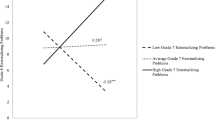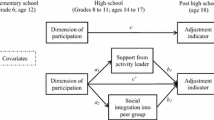Abstract
This longitudinal study examined psychopathology as a predictor and outcome of organized activity involvement during high school among 198 adolescents who varied in risk for psychopathology as a function of their mother’s depression history. Higher levels of internalizing and externalizing symptoms in eighth grade significantly predicted lower levels of involvement in academic clubs during high school, over and above risk and SES. Tobacco use prior to high school predicted lower levels of involvement overall and in academic clubs and performance arts. Controlling for psychopathology prior to high school, higher levels of activity involvement were associated with lower levels of externalizing symptoms, less tobacco use, and fewer diagnoses of behavior disorders and substance abuse in 12th grade. The positive association between risk and adolescent psychopathology was not buffered by adolescent activity involvement. Overall, these findings suggest that involvement in organized activities may contribute to lower levels of externalizing psychopathology during high school even when controlling for prior psychopathology.
Similar content being viewed by others
Notes
The AAII is available from the first author upon request.
References
Achenbach, T. M. (1991). Manual for the youth self-report and 1991 profile. Burlington, VT: University of Vermont, Department of Psychiatry.
Achenbach, T. M., McConaughy, S. H., & Howell, C. T. (1987). Child/adolescent behavioral and emotional problems: Implications of cross-informant correlations for situational specificity. Psychological Bulletin, 101, 213–232.
American Psychiatric Association (1987). Diagnostic and statistical manual of mental disorders (3rd ed., revised). Washington, DC: Author.
American Psychiatric Association (1994). Diagnostic and statistical manual of mental disorders (4th ed.). Washington, DC: Author.
Barber, B. L., Eccles, J. S., & Stone, M. R. (2001). Whatever happened to the jock, the brain, and the princess? Young adult pathways linked to adolescent activity involvement and social identity. Journal of Adolescent Research, 16, 429–455.
Barber, B. L., Stone, M. R., Hunt, J. E., & Eccles, J. S. (2005). Benefits of activity participation: The roles of identity affirmation and peer group norm sharing. In: J. L. Mahoney, R. W. Larson, & J. S. Eccles (Eds.), Organized activities as contexts of development: Extracurricular activities, after-school and community programs (pp. 185–210). Mahwah, NJ, US: Lawrence Erlbaum.
Bartko, W. T., & Eccles, J. S. (2003). Adolescent participation in structured and unstructured activities: A person-oriented analysis. Journal of Youth and Adolescence, 32, 233–241.
Beardslee, W. R., & Podorefsky, D. (1988). Resilient adolescents whose parents have serious affective and other psychiatric disorders: The importance of self-understanding and relationships. American Journal of Psychiatry, 145, 63–69.
Beardslee, W. R., Versage, E. M., & Gladstone, T. R. G. (1998). Children of affectively ill parents: A review of the past 10 years. Journal of the American Academy of Child and Adolescent Psychiatry, 37, 1134–1141.
Chi, T. C., & Hinshaw, S. P. (2002). Mother–child relationships of children with ADHD: The role of maternal depressive symptoms and depression-related distortions. Journal of Abnormal Child Psychology, 30, 387–400.
Conrad, M., & Hammen, C. (1989). Role of maternal depression in perceptions of child maladjustment. Journal of Consulting and Clinical Psychology, 57, 663–667.
Darling, N. (2005). Participation in extracurricular activities and adolescent adjustment: Cross-sectional and longitudinal findings. Journal of Youth and Adolescence, 34, 493–505.
De Los Reyes, A., & Kazdin, A. E. (2005). Informant discrepancies in the assessment of childhood psychopathology: A critical review, theoretical framework, and recommendations for further study Psychological Bulletin, 131, 483–509.
Dishion, T. J., Spracklen, K. M., Andrews, D. W., & Patterson, G. R. (1996). Deviancy training in male adolescents friendships. Behavior Therapy, 27, 373–390.
Eccles, J. S., Adler, T. F., Futterman, R., Goff, S. B., Kaczala, C. M., Meece, J. L., et al. (1983). Expectancies, values, and academic behaviors. In: J. T. Spence (Ed.), Achievement and achievement motivation (pp. 75–146). San Francisco, CA: Freeman.
Eccles, J. S., & Barber, B. L. (1999). Student council, volunteering, basketball, or marching band: What kind of organized involvement matters? Journal of Adolescent Research, 14, 10–43.
Eccles, J. S., & Barber, B. L. (2001). Student council, volunteering, basketball, or marching band: What kind of extracurricular involvement matters? In A. Yiannakis, & M. J. Melnick (Eds.), Contemporary issues in sociology of sport (pp. 125–142). Champaign, IL: Human Kinetics.
Eccles, J. S., & Gootman, J. A. (Eds.). (2002). Community programs to promote youth development. Committee on Community-Level Programs for Youth. Board on Children, Youth, and Families, Commission on Behavioral and Social Sciences and Education, National Research Council and Institute of Medicine, Washington, DC: National Academy Press.
Eccles, J. S., & Templeton, J. (2002). Extracurricular and other after-school activities for youth. Review of Research in Education, 26, 113–180.
Fletcher, A. C., Elder, G. H., & Mekos, D. (2000). Parental influences on adolescent involvement in community activities. Journal of Research on Adolescence, 10, 29–48.
Fletcher, A. C., Nickerson, P., & Wright, K. L. (2003). Structured leisure activities in middle childhood: Links to well-being. Journal of Community Psychology, 31, 641–659.
Fletcher, A. C., & Shaw, R. A. (2000). Sex differences in association between parental behaviors and characteristics and adolescent social integration. Social Development, 9, 133–148.
Fredricks, J. A. & Eccles, J. S. (2006a). Extracurricular involvement and adolescent adjustment: Impact of duration, number of activities, and breadth of participation. Applied Developmental Science, 10, 132–146.
Fredricks, J. A., & Eccles, J. S. (2006b). Is extracurricular participation associated with beneficial outcomes? Concurrent and longitudinal relations. Developmental Psychology, 42, 698–713.
Garber, J. (2006). Depression in youth: A developmental psychopathology perspective. In: A. Masten, & A. Sroufe (Eds.), Multilevel dynamics in developmental psychopathology: Pathways to the future (pp. 181–242). New York: Guilford.
Goodman, S. H., & Gotlib, I. H. (1999). Risk for psychopathology in the children of depressed mothers: A developmental model for understanding mechanisms of transmission. Psychological Review, 106, 458–490.
Hammen, C. L. (1991). Depression runs in families: The social context of risk and resilience in children of depressed mothers. New York: Springer.
Hammen, C., & Brennan, P. A. (2001). Depressed adolescents of depressed and nondepressed mothers: Tests of an Interpersonal Impairment Hypothesis. Journal of Consulting and Clinical Psychology, 69, 284-294.
Hanks, M. P., & Eckland, B. K. (1976). Athletics and social participation in the educational attainment process. Sociology of Education, 49, 271–294.
Hansen, D. M., Larson, R. W., & Dworkin, J. B. (2003).What adolescents learn in organized youth activities: A survey of self-reported developmental experiences. Journal of Research on Adolescence, 13, 25–55.
Hart, E. L., Lahey, B. B., Loeber, R., & Hanson, K. S. (1994). Criterion validity of informants in the diagnosis of disruptive behavior disorders in children: A preliminary study. Journal of Consulting and Clinical Psychology, 62, 410–414.
Hollingshead, A. B. (1975). Four factor index of social status. Working paper. New Haven, CT: Department of Sociology, Yale University.
Howell, D. C. (1992). Statistical methods for psychology (3rd ed.). Belmont, CA: Wadsworth.
Kaufman, J., Birmaher, B., Brent, D., & Rao, U. (1997). Schedule for affective disorders and schizophrenia for school-age children-present and lifetime version (K-SADS-PL): Initial reliability and validity data. Journal of the American Academy of Child and Adolescent Psychiatry, 36, 980–988.
Keller, M. B., Lavoir, P. W., Friedman, B., Nielsen, E., Endicott, J., McDonalid-Scott, P., et al. (1987). The longitudinal interval follow-up evaluation. Archives of General Psychiatry, 44, 540–548.
Larson, R. W. (2000). Toward a psychology of positive youth development. American Psychologist, 55, 170–183.
Larson, R., Hansen, D., & Walker, K. (2005). Everybody’s gotta give: Development of initiative and teamwork within a youth program. In J. L. Mahoney, R. W. Larson, & J. S. Eccles (Eds.), Organized activities as contexts of development: Extracurricular activities, after-school and community programs (pp. 159–183). Mahwah, NJ, US: Lawrence Erlbaum.
Loeber, R. (1982). The stability of antisocial and delinquent child behavior: A review. Child Development, 53, 1431–1446.
Luthar, S. S., Shoum, K. A., & Brown, P. J. (2006). Extracurricular involvement among affluent youth: A scapegoat for “ubiquitous achievement pressures”? Developmental Psychology, 42, 583–597.
Mahoney, J. L. (2000). School organized activity participation as a moderator in the development of antisocial patterns. Child Development, 71, 502–516.
Mahoney, J. L., & Cairns, R. B. (1997). Do organized activities protect against early school dropout?. Developmental Psychology, 33, 241–253.
Mahoney, J. L., Cairns, R. B., & Farmer, T. W. (2003). Promoting interpersonal competence and educational success through extracurricular activity participation. Journal of Educational Psychology, 95, 409–418.
Mahoney, J. L., Harris, A. L., Eccles, J. S. (2006). Organized activity participation, positive youth development, and the over-scheduling hypothesis. Social Policy Report of the Society for Research in Child Development, 20, 1–31.
Mahoney, J. L., Schweder, A. E., & Stattin, H. (2002). Structured after-school activities as a moderator of depressed mood for adolescents with detached relations to their parents. Journal of Community Psychology, 30, 69–86.
Mahoney, J. L., & Stattin, H. (2000). Leisure activities and adolescent antisocial behavior: The role of structure and social context. Journal of Adolescence, 23, 113–127.
McHale, S. M., Crouter, A. C., & Tucker, C. J. (2001). Free-time activities in middle childhood: Links with adjustment in early adolescence. Child Development, 72, 1764–1778.
McNeal, R. B. (1995). Extracurricular activities and high school dropouts. Sociology of Education, 68, 62–81.
Osgood, D. W., Wilson, J. K., O’Malley, P. M., Bachman, J. G., & Johnston, L. D. (1996). Routine activities and individual deviant behavior. American Sociological Review, 61, 635–655.
Page, R. M., Hammermeister. J., Scanlan, A., & Gilbert, L. (1998). Is school sports participation a protective factor against adolescent health risk behaviors? Journal of Health Education, 29, l86–l92.
Posner, J. K., & Vandell, D. L. (1999). After-school activities and the development of low-income urban children: A longitudinal study. Developmental Psychology, 35, 868–879.
Radke-Yarrow, M. (1998). Children of depressed mothers. Cambridge: Cambridge University Press.
Richters, J. E. (1992). Depressed mothers as informants about their children: A critical review of the evidence for distortion. Psychological Bulletin, 112, 485–499.
Rodriguez, D., & Audrain-McGovern, J. (2004). Team sport participation and smoking: Analysis with general growth mixture modeling. Journal of Pediatric Psychology, 29, 299–308.
Spitzer, R. L., Williams, J. B. W., Gibbon, M., & First, M. B. (1990). User’s guide for the Structured Clinical Interview for DSM-III-R. Washington, DC: American Psychiatric Press.
Youniss, J., Yates, M., & Su, Y. (1997). Social integration: Community service and marijuana use in high school seniors. Journal of Adolescent Research, 12, 245–262.
Acknowledgement
This work was supported in part by grants (R29-MH45458; R01-MH57822; K02 MH66249) from the National Institute of Mental Health, and a Faculty Scholar Award (88-1214) and grant (961730) from the William T. Grant Foundation. Amy M. Bohnert was supported in part from an NIMH training grant (T32-MH18921). We appreciate the cooperation of the Nashville Metropolitan School District, Drs. Binkley and Crouch, and we thank the parents and children who participated in the project.
Author information
Authors and Affiliations
Corresponding author
Rights and permissions
About this article
Cite this article
Bohnert, A.M., Garber, J. Prospective Relations Between Organized Activity Participation and Psychopathology During Adolescence. J Abnorm Child Psychol 35, 1021–1033 (2007). https://doi.org/10.1007/s10802-007-9152-1
Received:
Accepted:
Published:
Issue Date:
DOI: https://doi.org/10.1007/s10802-007-9152-1




